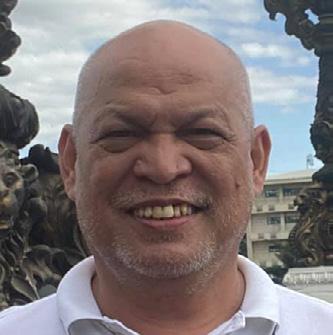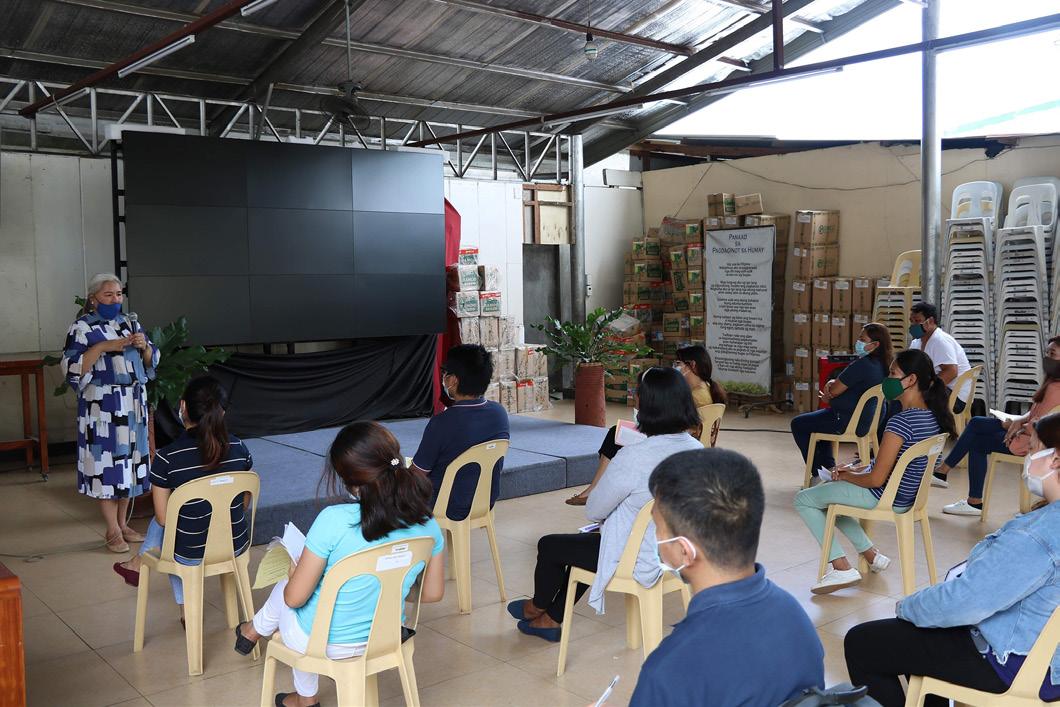10
FOR ADS PLACEMENT CALL OR TEXT: 0917-712-1424 • 0947-893-5776 E-mail: mindanaodaily.ads@gmail.com
Mon-Tue, August 24-25, 2020
Builds... from page 2
farm-to-market road in the area were used by CPP-NPA as propaganda in recruiting IPs to join the terrorist movement and in radicalizing the community. In 2019, the 88IB dealt with the influx of NPA rebels from the said community who surrendered and availed of the government’s Enhanced Comprehensive Local Integration Program (E-CLIP). These former rebels (FRs) then provided vital information on the whereabouts of other communist-terrorists in the area that resulted in the series of the government troops’ successful encounters, incapacitation of the terrorist leaders, seizure of NPA hideouts, and capture of numerous firearms and war materials. In fact, a former rebel and a newly graduated CAFGU Active Auxilliary a.k.a Toto, said in dialect, “Dako kaayo ko ug pasalamat kay daghan nabag-o sa akong kinabuhi paghuman namo ug surrender. Natagaan ko’g assistance ug gitagaan pa gyod ko ug trabaho. Pasalamat pud ko kay gitagaan pa mi’g dalan ug eskwelahan. Tanan namo nga lakaw padulong sa sentro sa barangay kay dali na. Imbis tulo ka oras,
karon tunga nalang sa oras. Dako sad ko ug pasalamat kay gihimo-an na gyud ug skwelahan among mga bata. Dati, pag abot sa barangay, kung asa ila eskwelahan kay manga-on na dayon tapos matulog. Walay klaro ang pag adto nila sa eskwelahan. Pero karon kay naa na dapit sa among duol. Maka-eskwela na gyud sila ug tarong.” (I thanked the government for the help. After we submitted ourselves to the authorities, my life has changed. The government gave me livelihood assistance and a CAA job. Our kids will no longer have to walk for hours from home to school because of the newly built two-classroom building. And finally, the three-hour walk from home to barangay proper now takes only half an hour (via motorcycle) because of the rehabilitation of the fourkilometer farm-to-market road) In a statement, Mayor Pablo Lorenzo III of Quezon town said “Mapasalamaton ang lokal nga pangagamhanan sa lungsod sa Quezon tungod sa pag-atiman ug pag-ayo sa dalan sa Purok 8, barangay Magsaysay. Usa kini ka bililhong gasa alang sa pagsiguro sa kahapsay ug kalinaw sa lungsod. Padayon nga nakig-alayon ang lokal
Personalized learning By MARIAE GIRLYNN M. RODRIGUEZ Teacher I Division of Misamis Occidental
TO recover all the ground they lost during the pandemic, students are going to need more than technology. No matter how many Clorox wipes they buy or how far apart they place desks, schools will not be returning to normal anytime soon due to continued public health concerns surrounding COVID-19 transmission. The grief of disrupted routines, short-circuited friendships and delayed academic milestones that had sunk in by March has been replaced with the stress of ongoing uncertainty. Among educators, a different kind of grief has been taking hold as they’re realized that school closures have cre-
ated a variance in students’ progress that is so great, it renders grade levels almost meaningless. While private schools achieved a degree of success with video-based lessons and digital assignments submitted via tools such as Google Meet, many struggled to adapt and many students have fallen behind. Much of the creative thinking in schools in recent years has centered around personalized learning, a term for the practice of modifying lessons, pacing and subject matter to meet the needs and interests of individual students. Personalized learning is an ideal way to tackle the problem at hand.
nga kagamhanan sa Quezon para sa maayong kaugmaon sa katawhan. Fabic, likewise said, “Let this be the start of a new life in your village. These projects and programs are proof of the government’s commitment to winning the peace and attaining development in far-flung communities. Let us protect these projects for a bright future of our younger generation.” (CMO, 88IB, 4ID, PA/PIA Bukidnon)
Nabbed... from page 2
Secretary of NEMRC who killed in an encounter with government forces at Sitio Panukmoan, Diatagon, Lianga in July this year. The suspects are now in the custody of the provincial police office in Surigao
Del Sur pending the filing of the appropriate criminal charges against them.
Constructs... from page 2
Task Force (Iligan IATF) led by FCI Butch Baulete, visited the identified sites to evaluate its suitability for an isolation center. “Initially, I was apprehensive that our barangay might be stigmatized because of our acceptance of COVID-19 patients. However, when DPWH District Engineer Alykhan Ali explained the importance of this facility, we began to see the impact of this project in our fight against the pandemic”, said Brg y. Acmac Chairwoman Juvilyn Claveria. (VNL/ DPWH-PIO)
CAGAYAN DE ORO MAIN BRANCH P & J Lim Bldg., Tiano Brothers Kalambagohan Sts., Tel. # (08822) 727-829 * Telefax # (088) 856-1947 CAMIGUIN BRANCH B. Aranas St., Poblacion, Mambajao, Camiguin Tel. # (088) 387-0491 CORRALES BRANCH Corrales Ave., Cagayan de Oro City DIVISORIA BRANCH Atty. Erasmo B. Damasing Bldg., #61 Don A. Velez St., Cagayan de Oro City Tel. # (088) 857-3631 LAPASAN BRANCH Lapasan Hi-way, Cagayan de Oro City Tel. # (088) 231-6739 CARMEN BRANCH Vamenta Blvd., Cagayan de Oro City Tel. # (088) 231-2011
CDO MAIN BRANCH P & J Lim Bldg., Tiano Brothers Kalambagohan Sts., Tel. # (08822) 727-829 * Telefax # (088) 856-1947
DIVISORIA BRANCH Atty. Erasmo B. Damasing Bldg., #61 Don A. Velez St., Cagayan de Oro City Tel. # (088) 857-3631
CAMIGUIN BRANCH B. Aranas St., Poblacion, Mambajao, Camiguin Tel. # (088) 387-0491
LAPASAN BRANCH Lapasan Hi-way, Cagayan de Oro City Tel. # (088) 231-6739
CORRALES BRANCH Corrales Ave., Cagayan de Oro City
CARMEN BRANCH Vamenta Blvd.,Cagayan de Oro City Tel. # (088) 231-2011
Philippine public school teachers’ webinar By ANNABELLE J. LARIBA Principal III Gusa Elementary School
THE COVID-19 pandemic challenges schools to deliver classroom instruction remotely. This is challenging because students and teachers do not have equal access to technologies and stable Internet connection. Despite the overwhelming digital divide, schools are told that education must continue. This led to schools’ learning continuity plans incorporating teachers’ retooling and reskilling through online professional development seminars aka webinars. Since May, professional organizations, publishing houses and DepEd have begun staging free, daily webinars for Filipino teachers using webconferencing applications and Facebook Live. So, why the webinar craze? Webinars suit the current con-
ditions of the pandemic. They offer flexibility and sustained availability because sessions are accessible anywhere and recordings can be replayed on demand. Webinars are also a costeffective way for schools to do teacher-training since they do not involve added expenses for logistics, speakers’ honoraria, venue rentals, participants’ food and printing of certificates. What motivates Filipino teachers to attend webinars? First, they are free and second, they give a certificate of participation. Webinars democratize professional development by abolishing expensive seminar fees and limited access to training by experts. Webinars also become a fast, cost-effective way to earn promotion and ranking points.
BLACK LIVES MATTER: A COMMENTARY ON CONDEMNED RACISM, DEMANDED JUSTICE, AND PUBLIC HEALTH By VALENTINA G. REDOBLE-TEJANO, PhD School Head/HT-III Maac National High School Division of Camiguin
“I can’t breathe.” “Hands up.” “Black lives matter.” These statements developed in reaction to the recent deaths of Eric Garner, an unarmed Black man strangled to death by police in Staten Island, New York, Michael Brown, an unarmed Black adolescent shot to death by police in Ferguson, Missouri, and George Floyd, a 46 year old who suffered a cardiac arrest while being restrained by Minneapolis police. To racial scholars, activists, and many community members, these preventable deaths were only two recent examples of the stark racial injustices that have plagued our country’s history. In both instances, the White police officers responsible for the deaths were neither charged with any crime, nor taken to trial. However, despite the national and international media attention
these cases drew, they are by no means isolated incidents. Moreover, despite the media’s disproportionate focus on cases involving men, intersectional analyses demonstrate that racialized police violence and misconduct are inflicted upon women and transgendered persons of color as well. Such cases bring to light how racism, defined as a “system of structuring opportunity and assigning value based on race, that unfairly disadvantages some individuals and communities,” and advantages others, affects the daily realities in communities of color. As public health professionals, one is committed to achieving optimal health for all. Thus, these violent, premature deaths of people of color should enrage us because they directly oppose the vision of Healthy People 2020, “A society in which all people live long, healthy lives.” Therefore, our
commentary calls upon our field to recognize the pervasive role of racism in public health and to reshape our discourse and agenda so that one could call actively engage in racial justice work. Race and racism are not interchangeable constructs. Each needs its own distinct conceptualization, measurement, and analysis for public health research. Race is a social construction with no biological basis, whereas racism refers to a social system that reinforces racial group inequity. Accordingly, being Black in America (a racially stratified society) has negative implications for educational and professional trajectories, socioeconomic status, and access to health care services and resources that promote optimal health, which in combination, may reduce or exacerbate health risks. In a racially stratified society, White lives are inherently valued over Black lives. Racism permeates our everyday lives, even if we do not readily
acknowledge its power or pervasiveness. One argues that addressing racism is central to eliminating racialized health disparities, and therefore, should be central to public health research and practice. We echo the principles of an “open society,” one that is based on social justice that recognizes the equal value of all lives. Each individual should believe that collective efforts can help evoke social change and more generally reduce racialized health disparities and inequality. With this, the tragic deaths of Eric Garner, Michael Brown, and George Floyd should remind one that as public health professionals one must critically evaluate one’s work, values, and impact vis-à-vis racism. Each is convinced that one has an ethical and professional responsibility to address racism as an inherent component of health equity and optimal health for all. Each must be reminded that Black lives matter and that the field of public health can guide the nation toward ensuring they do.
Do learning pods endanger equality? By MERCEDES C. BERNAD, Teacher III Maningcol Central School Division of Ozamiz City
NO schooling plans in the time of the coronavirus are going to solve racism or the disparity between rich and poor. Alluding to white supremacy won’t help either. All parents will do what is best for their own children especially in a crisis. As poor and therefore, many minority parents have fewer resources to help their children, the government must come in to address the inequity. Providing computers, Internet access and money for day care may help since we failed to address the COVID-19 virus in time for schools to reopen. Facing the systematic racism in society means changing laws and policies that disadvantage minority groups. Help addicts and
young people rather than lock them up. Train the police to defuse situations rather than threaten violence. Ensure fair elections. Provide health care for the sick and working poor. And so on. But let’s use this special moment in our history to have some necessary, tough conversations and build some critical community bridges. As far as the learning pods are concerned, perhaps principals and teachers can make proactive calls today to those parents forming such pods and ask if they are willing to add some low-income kids even if their parents can’t contribute much. Find low-income parents willing to participate in this arrangement.
Fostering a safe environment for learners with special needs By MARGORIE O. GUIRITAN SPET I Mambajao Central School
Children with disabilities—such as physical, developmental, intellectual, emotional, and sensory disabilities—are at an increased risk of being bullied. Any number of factors— physical vulnerability, social skill challenges, or intolerant environments—may increase the risk. Children who are bullied face many social and emotional risks, including a greater chance of feeling depressed or anxious, being lonely, and having low selfesteem. Other impacts of bullying can include headaches or problems sleeping, poor attendance at school, low motivation and a drop in academic performance; in extreme cases, suicidal
thoughts or actions may occur. Although many children may be bullied at one time or another, children with disabilities appear to be especially vulnerable to being the targets of repeated aggression from their peers. More so, in order for us to create a safe environment for learners with special needs who are at risk of bullying, let us be supportive of the child and encourage him or her to describe who was involved and how and where the bullying or harassment happened. Be sure to tell the child that it is not his or her fault and that nobody deserves to be bullied or harassed. Do not encourage your child to fight back. This may make the problem much worse.
Being a mother and a Special Education teacher By MARGORIE O. GUIRITAN SPET I Mambajao Central School
The double duty job of being a mother and a teacher is something that someone cannot even come to comprehend until they have experienced it themselves. The combination itself would leave many people running after just one week. It is a job that is meant only for those with skin of steel and a heart of gold, well maybe platinum. There are days of complete and utter defeat, the days in which you feel you have failed at life and the will to go on is slim. Then there are the days of complete and utter joy that would leave you wanting to cartwheel down the hallway if it was not for a fear of breaking your wrists! These are the days that make the constant stress, endless work, and horrific nightmares of failing lesson plans all worth it. And yes, being a mother means that I only have four hours a day with my children, a time that goes by with a blink of the eye. I do not have all day with my small children to bond with them
and teach them about life, while teaching them the ABC’s and 123’s. Sad to say, many people frown upon working mothers, saying that we do not have time to teach our children values and morals. They say that staying at home with their children makes better children. But I feel that is completely false and that working moms deserve a great deal of credit. We teach our children about having a strong work ethic. Teachers especially, teach their children about the importance of education and working hard to achieve things. We also value our time with our children and take advantage of every moment that we do have with them. It is not an easy job but it is the most fulfilling job of all time. My life is very precious and that amidst all the deadlines and dilemmas, still, I will not trade these roles to something else. Being a mother while being a Special Education teacher is truly heartwarming.







